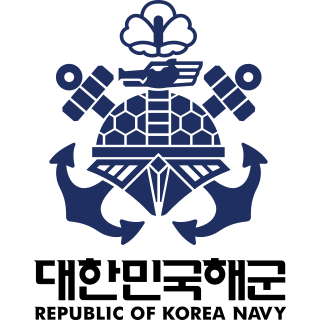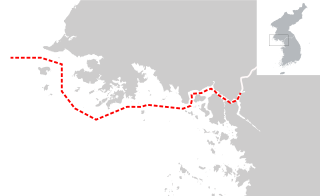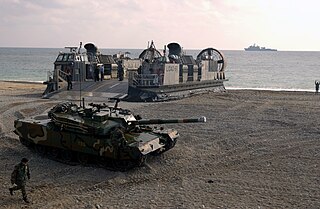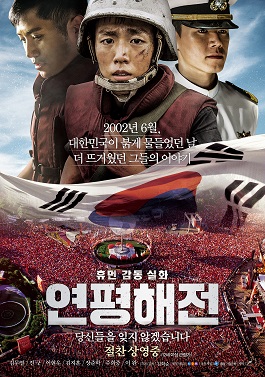
The Republic of Korea Navy, also known as the ROK Navy or South Korean Navy, is the naval warfare service branch of the South Korean armed forces, responsible for naval and amphibious operations. The ROK Navy includes the Republic of Korea Marine Corps, which functions as a branch of the Navy. The ROK Navy has about 70,000 regular personnel including 29,000 Republic of Korea Marines. There are about 140 commissioned ships in the ROK Navy. The naval aviation force consists of about 70 fixed-wing and rotary-wing aircraft. The ROK Marine Corps has about 300 tracked vehicles including assault amphibious vehicles.

The United States Forces Korea (USFK) is a sub-unified command of U.S. Indo-Pacific Command (USINDOPACOM). USFK is the joint headquarters for U.S. combat-ready fighting forces and components under the ROK/US Combined Forces Command (CFC) – a supreme command for all of the South Korean and U.S. ground, air, sea and special operations component commands. Major USFK elements include U.S. Eighth Army (EUSA), U.S. Air Forces Korea, U.S. Naval Forces Korea (CNFK), U.S. Marine Forces Korea (MARFORK) and U.S. Special Operations Command Korea (SOCKOR). It was established on July 1, 1957.

Baengnyeong Island is a 45.8-square-kilometre (17.7 sq mi), 8.45-kilometre (5.25 mi) long and 12.56-kilometre (7.80 mi) wide island in Ongjin County, Incheon, South Korea, located near the Northern Limit Line. The 1953 Korean Armistice Agreement which ended the Korean War specified that the five islands including Baengnyeong Island would remain under United Nations Command and South Korean control. This agreement was signed by both North Korea and the United Nations Command. Since then, it has served as a maritime demarcation between North and South Korea in the Yellow Sea. It has a population of approximately 4,329.

The Northern Limit Line or North Limit Line (NLL) – 북방한계선 – is a disputed maritime demarcation line in the Yellow (West) Sea between the Democratic People's Republic of Korea (DPRK) in the north, and the Republic of Korea (ROK) in the south. This line of military control acts as the de facto maritime boundary between North and South Korea.

The history of the Korean People's Army Naval Force is short compared to most modern navies. It began with the creation of a "Maritime Security Force" on June 5, 1946. The headquarters for the force was based in the North Korean city of Wonsan, and was operational by July 1946. The headquarters were then expanded and moved to the capital, Pyongyang, for more effective management of seabound traffic, and the forces were renamed Marine Patrols in December of the same year. The Marine Patrol Academy was established in Wonsan in June 1947 in order to train and commission a professional corps of naval officers.

The Battle of Yeonpyeong took place between the navies of the Democratic People's Republic of Korea and the Republic of Korea on 15 June 1999, off the island of Yeonpyeong.

The Battle of Yeongpyeong was a confrontation at sea between North Korean and South Korean patrol boats along a disputed maritime boundary near Yeonpyeong Island in the Yellow Sea in 2002. This followed a similar confrontation in 1999. Two North Korean patrol boats crossed the contested border and engaged two South Korean Chamsuri-class patrol boats. The North Koreans withdrew before South Korean reinforcements arrived.
The Republic of Korea Navy was founded on November 11, 1945 as Marine Defense Group after Korea was liberated from the Empire of Japan. The ROK Navy is the oldest service within the ROK Armed Forces. In 2015, the South Korean navy celebrated its 70th anniversary.

The Pohang-class PCC is the low-end complement of the high-low mix domestic naval construction plan of the Republic of Korea Navy under the 1st Yulgok Project (1974-1986) for the Republic of Korea Armed Forces. It was originally planned as a Batch II production of Donghae-class corvette, but many changes on overall design, notably applying the hull design of Ulsan-class frigate, reclassified the ship to its own class. The ship is designed for patrolling maritime border, including the Northern Limit Line, protecting the littoral zone, and combating the North Korean vessels.

The 1998 Yeosu submersible incident was a naval skirmish that occurred off of the southern coast of South Korea between 17 and 18 December 1998. On the evening of 17 December, a South Korean observation post sighted a North Korean semi-submersible naval vessel in the vicinity of the city of Yeosu. The semi-submersible was discovered and sunk during a subsequent search and skirmish on the morning of 18 December.

Yeonpyeong Island or Yeonpyeongdo is a group of South Korean islands in the Yellow Sea, located about 80 km (50 mi) west of Incheon and 12 km (7.5 mi) south of the coast of Hwanghae Province, North Korea. The main island of the group is Daeyeonpyeongdo, also referred to simply as Yeonpyeong Island, with an area of 7.01 km2 (2.71 sq mi) and a population of around 1,300.

The ROKS Cheonan sinking occurred on 26 March 2010, when Cheonan, a Pohang-class corvette of the Republic of Korea Navy, carrying 104 personnel, sank off the country's west coast near Baengnyeong Island in the Yellow Sea, killing 46 seamen. The cause of the sinking remains in dispute.

ROKS Cheonan (PCC-772) was a Pohang-class corvette of the Republic of Korea Navy (ROKN), commissioned in 1989. On 26 March 2010, she broke in two and sank near the sea border with North Korea, killing 46 sailors. An investigation conducted by an international team of experts from South Korea, United States, United Kingdom, Canada, Australia, and Sweden concluded that Cheonan was sunk by a torpedo launched by a North Korean Yeono-class miniature submarine.

The Bombardment of Yeonpyeong was an artillery engagement between the North Korean military and South Korean forces stationed on Yeonpyeong Island on 23 November 2010. Following a South Korean artillery exercise in disputed waters near the island, North Korean forces fired around 170 artillery shells and rockets at Yeonpyeong Island, hitting both military and civilian targets.

Daecheongdo or Daecheong Island is a 12.63 km2 (4.88 sq mi), 7 km (4.3 mi) long and 6.3 km (3.9 mi) wide island in Ongjin County, Incheon, South Korea, near the Northern Limit Line.
The 2010 Yellow Sea conflict may refer to the following incidents:

Foal Eagle is a combined field training exercise (FTX) conducted annually by the Republic of Korea Armed Forces and the United States Armed Forces under the auspices of the Combined Forces Command. It is one of the largest military exercises conducted annually in the world. Foal Eagle has been a source of friction with the government of Democratic People's Republic of Korea (DPRK) and domestic ROK critics.

The Korean People's Army Navy (KPANF; Korean: 조선인민군 해군; Hanja: 朝鮮人民軍 海軍; MR: Chosŏn-inmingun Haegun; lit. Korean People's Military Navy; or the Korean People's Navy, is the naval component of the Korean People's Army, the North Korean armed forces.

Northern Limit Line is a 2015 South Korean naval thriller film written and directed by Kim Hak-soon, based on the real-life events of the Second Battle of Yeonpyeong. It stars Kim Mu-yeol, Jin Goo, and Lee Hyun-woo.

















